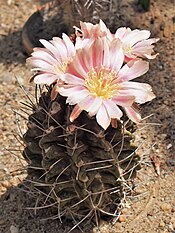| Notocacteae | |
|---|---|

| |
| Parodia werneri | |
|
Scientific classification
| |
| Kingdom: | Plantae |
| Clade: | Tracheophytes |
| Clade: | Angiosperms |
| Clade: | Eudicots |
| Order: | Caryophyllales |
| Family: | Cactaceae |
| Subfamily: | Cactoideae |
| Tribe: | Notocacteae |
| Type genus | |
|
Notocactus | |
| Genera | |
|
See text | |
Notocacteae is a tribe of cacti belonging to the subfamily Cactoideae. [1] It is one of the oldest cactus lineages endemic to South America. [2]
Description
Notocacteae are mostly single, rarely tree-like or shrub-like plants. Their mostly spherical, non-articulated shoots are ribbed, ribbed-warty or warty. The small to medium-sized, polysymmetrical to disymmetrical flowers open during the day. Their pericarpel has small scales. The areoles bear bristles or hairs. The fruits that burst or do not burst are usually dry and rarely berry-like. The small to medium-sized seeds are diverse in shape. The hilum and micropyle of the seeds are fused together, a strophiole is often present, and a slimy coating is sometimes present.
Genera
| Image | Genus | Synonyms | Living species |
|---|---|---|---|

|
Copiapoa Britton & Rose,1922 | Pilocopiapoa |
33 species:
|

|
Eriosyce Phil. 1872 | Chilenia, Chileniopsis, Horridocactus, Islaya, Neochilenia, Neoporteria, Pyrrhocactus, Reicheocactus, Rodentiophila, Thelocephala |
56 species:
|

|
Neowerdermannia Fric, 1930 |
| |

|
Parodia Speg. 1923 | Brasilicactus, Brasiliparodia Echinocactus subg. Notocactus, Eriocactus, Notocactus, Wigginsia | 66 species:
|

|
Yavia R.Kiesling & Piltz 2001 |
|
References
- ^ Fleming, Theodore H.; Valiente-Banuet, Alfonso (August 2002). Columnar Cacti and Their Mutualists: Evolution, Ecology, and Conservation. University of Arizona Press. pp. 51–60. ISBN 978-0-8165-2204-0.
- ^ Guerrero, Pablo C.; Walter, Helmut E.; Arroyo, Mary T. K.; Peña, Carol M.; Tamburrino, Italo; De Benedictis, Marta; Larridon, Isabel (June 2019). "Molecular phylogeny of the large South American genus Eriosyce (Notocacteae, Cactaceae): Generic delimitation and proposed changes in infrageneric and species ranks". Taxon. 68 (3): 557–573. doi: 10.1002/tax.12066. ISSN 0040-0262. S2CID 202864508.